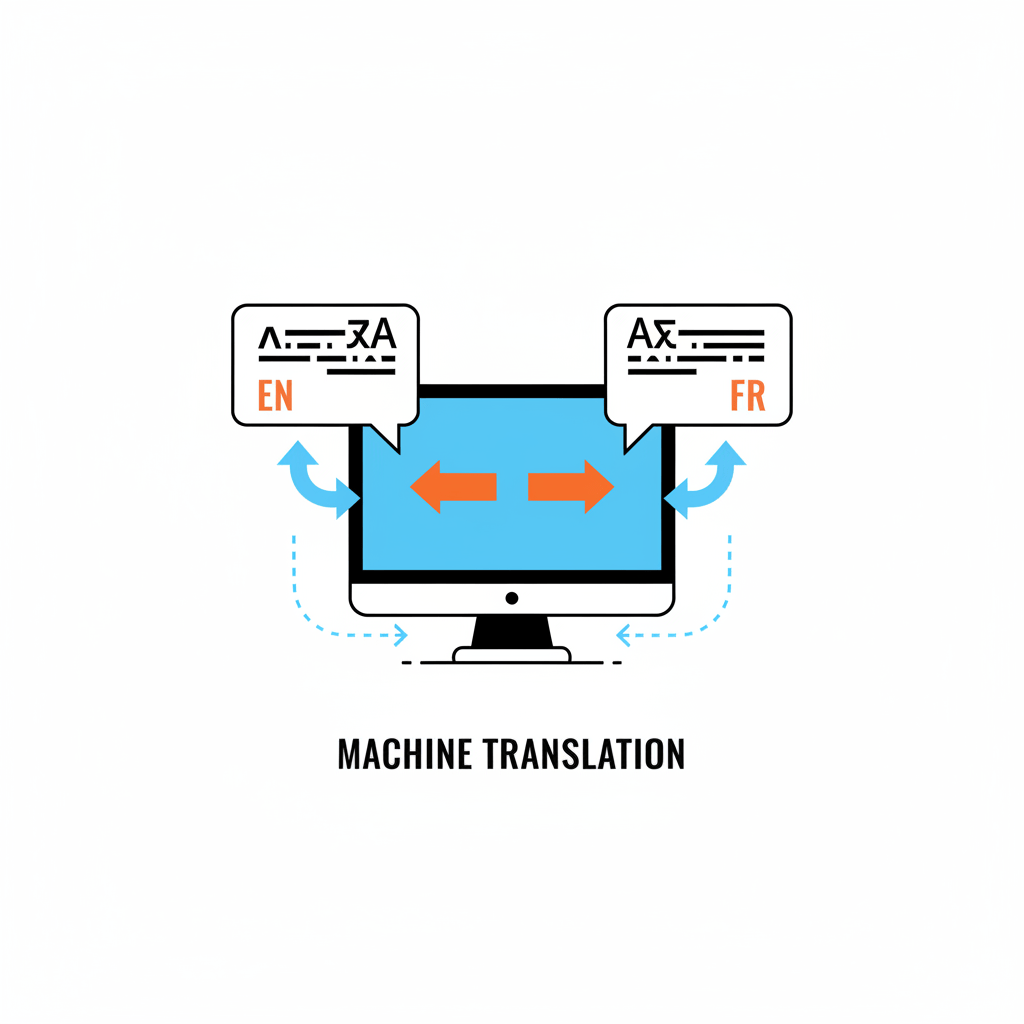International SEO Strategy: 9 Essential Steps to Drive Global Growth in 2025
By Lokotor James
November 2025 – 16 min read
The Strategic Case for International SEO in 2025
Global expansion through organic search has become the defining competitive advantage for digital-forward businesses. When executed with precision, an international SEO strategy transforms your website into a multilingual revenue engine—reaching customers exactly when they search in their own language.

Organic search conversion rates dramatically outperform outbound marketing methods in 2025
The numbers tell a compelling story. According to G2’s 2025 marketing insights, organic search leads convert at rates up to 14.6%, far outpacing outbound campaigns at just 1.7%. For companies serious about sustainable international growth, this gap isn’t just a statistic—it’s a business imperative.
Applied Lingo has spent years helping brands unlock this potential. This comprehensive guide walks you through nine proven steps to build a global SEO framework that works—from domain architecture and technical foundations to culturally nuanced content that earns both rankings and trust across every target market.
Understanding International SEO: Definition and Scope
International SEO is the practice of optimizing your website to rank effectively across multiple languages and geographic regions. It goes far beyond simple translation.
True international SEO requires harmony between three forces:
Technical precision (domain setup, hreflang implementation, site speed)
Linguistic expertise (native keyword research, cultural adaptation)
Content strategy (market-relevant topics, continuous optimization)
When these align, your brand becomes visible to the right audience, in the right language, at the right moment in their search journey.
Why International SEO Delivers Competitive Advantage
Organizations that invest in international SEO gain measurable advantages:
Expanded market reach across language “niches” with lower competitive saturation
Enhanced customer trust through localized, culturally resonant experiences
Diversified organic traffic reducing dependence on any single market
Sustainable growth that compounds as domain authority builds across regions
The data supports this. According to Statista (2025), English websites represent 52% of global web presence, while Spanish, German, French, and Russian collectively comprise less than 20%. That massive imbalance reveals untapped markets where ranking friction remains remarkably low compared to saturated English-language niches.
For B2B and SaaS companies especially, spreading SEO effort across languages doesn’t just capture new visitors—it boosts overall domain authority and signals to search engines that your brand operates at a genuinely international scale.
Five Critical Mistakes That Derail International SEO
Before implementing your strategy, understand what not to do:
Treating translation as a commodity. Pasting website content into an AI translator and calling it localized is a recipe for poor rankings and eroded trust.
Ignoring local keyword research. Literal translations never align with actual search intent in target markets.
Overlooking technical setup. Misconfigured hreflang tags, poor site speed, and duplicate content penalties will cripple your efforts.
Hiring reviewers unfamiliar with local culture. Native speakers aren’t optional—they’re essential for catching colloquialisms, regional preferences, and brand voice consistency.
Publishing once and abandoning content. Localized pages require the same ongoing optimization and updates as your primary market site.
Applied Lingo has seen each of these mistakes drain resources and stall international growth. Avoiding them is half the battle.
The 9 Steps to Build a Winning International SEO Strategy
Step 1: Analyze Target Markets with SEO Intelligence
The foundation of any global expansion is data-driven market selection. Don’t guess where to expand—measure it.
Start with Google Analytics 4 (GA4): Navigate to Reports > User Attributes > Demographic details to identify countries already sending meaningful traffic or conversions. Real-world engagement often reveals quick-win markets that desk research alone misses.
Complement this with competitive intelligence tools like Semrush or Ahrefs, which reveal:
Where your competitors rank strongest
Which geographic markets show lower ranking difficulty
Seasonal or industry-specific opportunities in specific regions
A SaaS company noticing rising India-based traffic might discover an underdeveloped market opportunity. A European e-commerce brand might spot that Scandinavian competitors rank easily in mid-tier keywords—a signal to prioritize that region.
The goal: identify markets with genuine demand and manageable SEO competition.
Step 2: Choose Between Country-Specific or Language-Based Targeting
Your expansion model depends on your business structure and audience:
Country-specific targeting makes sense if you need to:
Display prices in local currency
Comply with regional regulations
Serve culturally distinct audiences
Example: A retailer launching in Germany, Austria, and Switzerland would benefit from country-specific sites because each market has distinct legal requirements and customer expectations—even though all speak Deutsch.
Language-based targeting works better if you:
Serve a linguistically cohesive audience across multiple countries
Want to minimize technical complexity
Have limited localization resources
Example: A Spanish-language educational platform can serve Spain, Mexico, Colombia, and Argentina from a single Spanish-language domain, avoiding the overhead of managing four separate country sites.
Most mid-market companies find a hybrid approach most efficient: language-primary targeting with country-specific landing pages for top-performing regions.
Step 3: Select Your Domain Architecture Strategy
Domain structure directly influences how search engines interpret geotargeting and how quickly you build SEO authority. You have three primary options:
| Structure | Example | Best For | Key Advantage | Key Challenge |
|---|---|---|---|---|
| Country Code TLD (ccTLD) | applied-lingo.de | E-commerce, highly localized brands | Maximum local trust; preferred ranking in local search | High cost; slow authority building; domain fragmentation |
| Subdomain | de.applied-lingo.com | Multi-language platforms, software | Clear content separation; easier management | Slower to establish independent authority |
| Subdirectory | applied-lingo.com/de | Most companies; scalable growth | Inherits main domain authority; simplest management | Less precise geotargeting signal |
Applied Lingo’s recommendation: For most growing companies, subdirectories offer the best balance of scalability and SEO efficiency. You leverage your primary domain’s authority while maintaining clean content separation and straightforward management.
Step 4: Build a Technical SEO Foundation That Scales
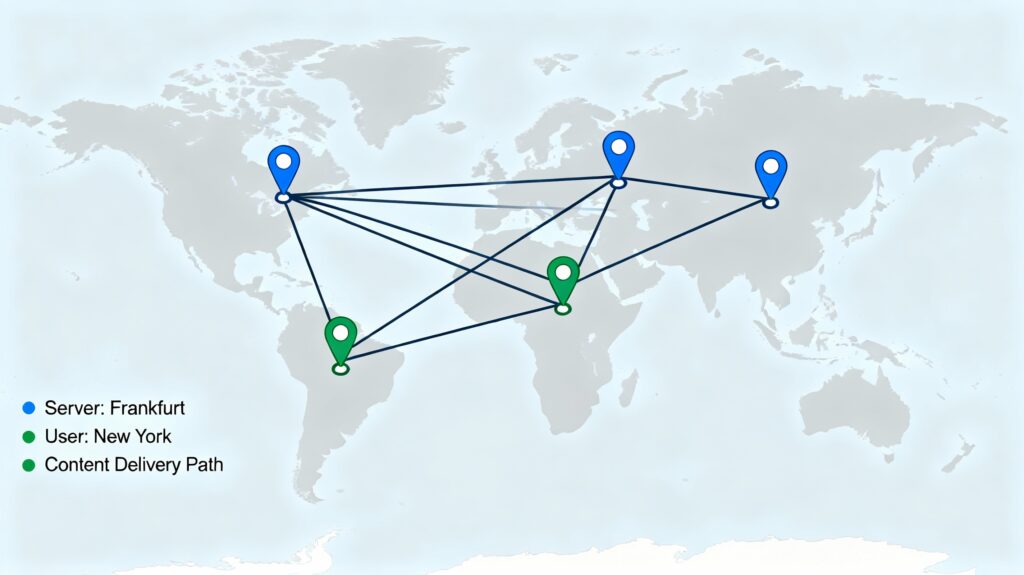
Content Delivery Networks accelerate page load times for international visitors
Without technical precision, exceptional content won’t rank. Focus on these three non-negotiables:
Implement Hreflang Correctly
Hreflang tags tell search engines exactly which language and country version to serve to each user. Google’s Senior Search Analyst John Mueller once called hreflang “one of the most complex aspects of SEO”—and he wasn’t exaggerating.
Best practices:
Make all hreflang links bidirectional (each page references every alternate version and vice versa)
Include an x-default tag to catch users from regions you haven’t localized for
Keep canonical URLs synchronized with hreflang declarations to prevent mixed signals
Update your sitemap every time you add or remove language versions
Optimize for Global Page Speed
International users experience slower load times by default—unless you’ve deployed infrastructure to solve it. A Content Delivery Network (CDN) distributes your site’s content across geographically dispersed servers, serving pages from the data center nearest to each visitor.
CDN setup typically adds 30-50% speed improvements for international users and signals site maturity to search engines.
Build Local Backlink Authority
New domains or new country-specific domains start with zero SEO authority. Building high-quality, locally relevant backlinks accelerates that growth.
Process:
Research local websites, news outlets, and industry directories relevant to your target market
Evaluate their domain authority using tools like Semrush’s DA checker
Create genuinely valuable content (guest posts, research, resources) that warrants a link from these high-authority local sources
Ensure backlinks use dofollow attributes pointing to the correct country domain
This is where professional translation services become strategic—you need content that’s not just grammatically correct but compelling enough to earn editorial links in competitive local markets.
Step 5: Optimize for Dominant Local Search Engines
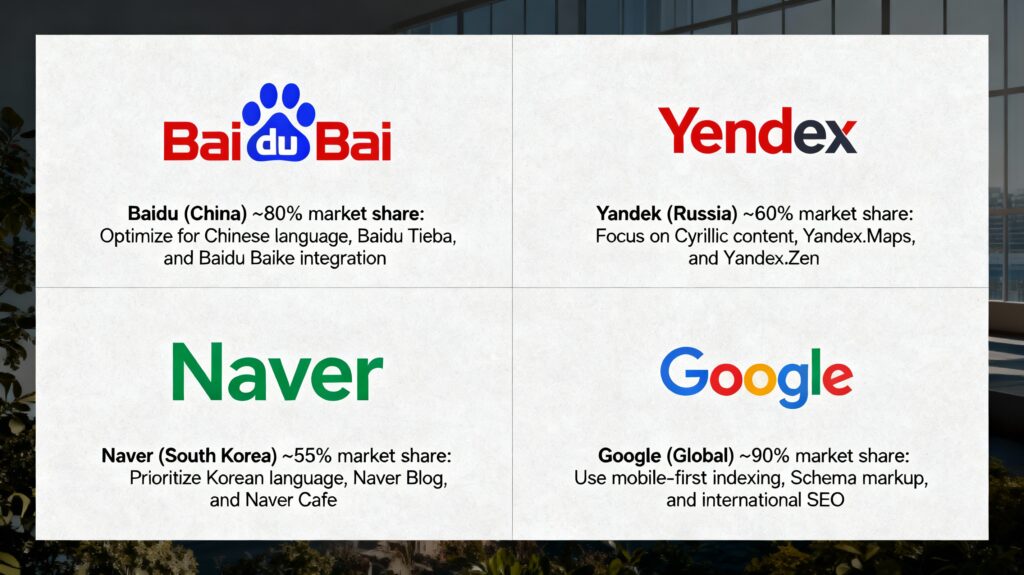
Regional search engines require tailored optimization strategies beyond Google
While Google commands 80%+ global market share, it doesn’t reign everywhere. Each region has preferences—and each search engine ranks differently:
Baidu (China)
Prioritizes mobile-first pages
Favors content hosted on servers within mainland China
Rewards fresh, frequently updated content
Penalizes sites with excessive external links
Yandex (Russia)
Prefers server-side rendered content over heavy JavaScript
Values social signals from Russian platforms
Ranks sites hosted in Russia higher
Naver (South Korea)
Rewards community engagement and fresh content
Ranks blog posts, Q&A pages, and user-generated content highly
Values social signals from Korean platforms like Kakao and Line
If your target markets include these regions, you’ll need to tailor your technical setup, content formats, and hosting strategy accordingly. This isn’t optional—it’s the difference between ranking and invisibility in those markets.
Step 6: Conduct Localized Keyword Research (Never Translate Literally)
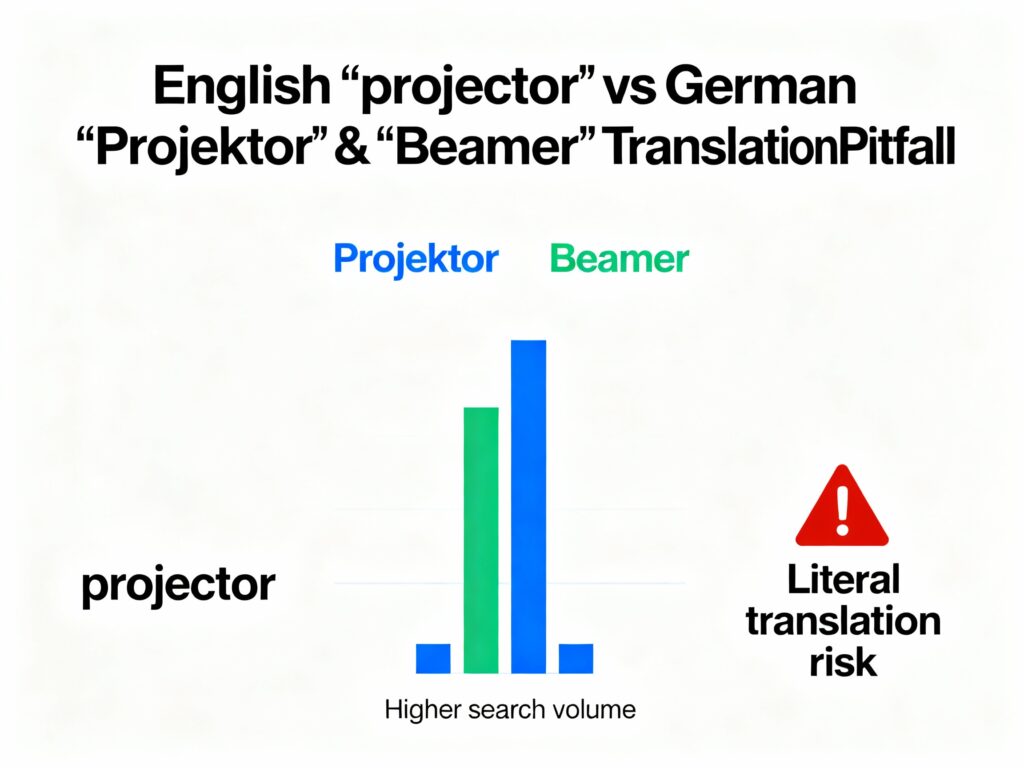
Literal keyword translation often misses high-volume local search terms
This is where many companies derail their international SEO efforts: they translate their English keywords directly into target languages. This almost always fails.
Real example: The English word “projector” translates to Projektor in German. But German consumers search for Beamer—the colloquial term. A site optimized for Projektor will miss the high-intent traffic searching for Beamer.
Proper localized keyword research requires:
Native speaker insights to identify colloquialisms, regional preferences, and industry jargon
Local search volume data from tools like Google Keyword Planner, Semrush, or Sistrix
Competitor analysis to understand which keywords drive rankings in each target market
Cultural context around how customers actually search in that region
Markets also vary dramatically in keyword volume. “CRM system” generates 12,000 monthly searches in the U.S. but only 110 in Slovenia. Niche B2B topics sometimes have zero searchable volume in smaller languages, requiring you to create different content strategies for different regions.
Applied Lingo specializes in this precise intersection of linguistics and SEO—ensuring your keywords aren’t just translated but strategically positioned for each market’s search behavior.
Step 7: Audit and Strategically Repurpose Your Content
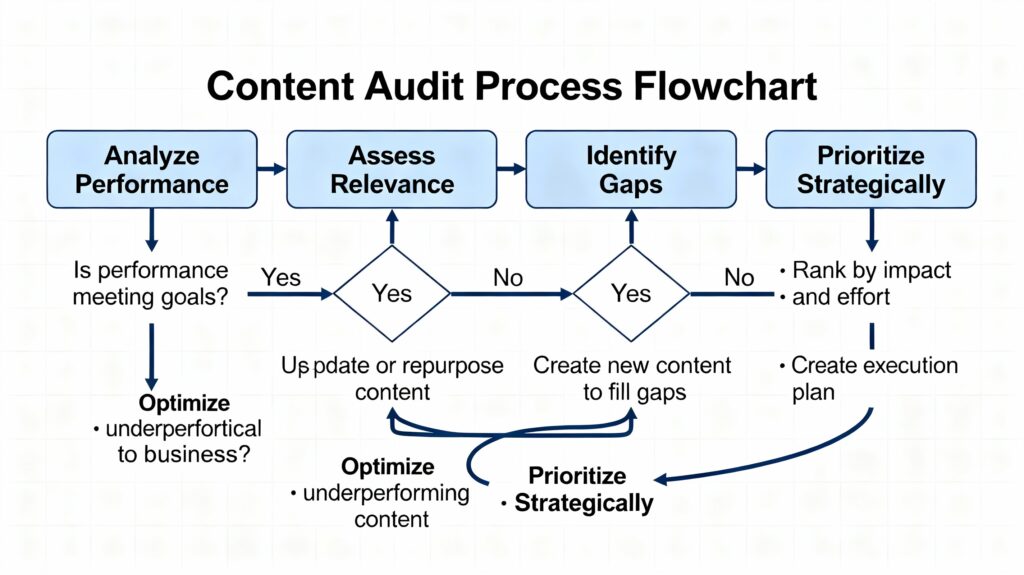
Strategic content audit framework for international SEO readiness
You likely have high-performing content in your primary market. Can you simply duplicate it across other language versions?
Partially, yes—but only with strategic adaptation. A thorough content audit determines what to recycle, refine, or rebuild from scratch.
Analyze performance and relevance:
Which pages generate the most traffic and conversions in your home market?
Which topics are actually relevant to audiences in target markets?
Consider: An article on new EU GDPR regulations matters enormously to European audiences but is irrelevant to North American or Asian readers. Cultural and regulatory differences mean content relevance varies by region.
Identify gaps:
Localized keyword research often surfaces topics that matter in target markets but that you haven’t covered at all. These become candidates for new content creation, giving you first-mover advantage in those markets.
Prioritize strategically:
Focus repurposing effort on your highest-impact content—pages that drive conversions, establish authority, or rank for competitive keywords. Lower-performing blog pieces can wait or be deprioritized entirely.
Step 8: Localize Content Through Professional Translation and Transcreation
This is where Applied Lingo’s core expertise shines. Localization is not translation; it’s transformation.
Three approaches to localized content:
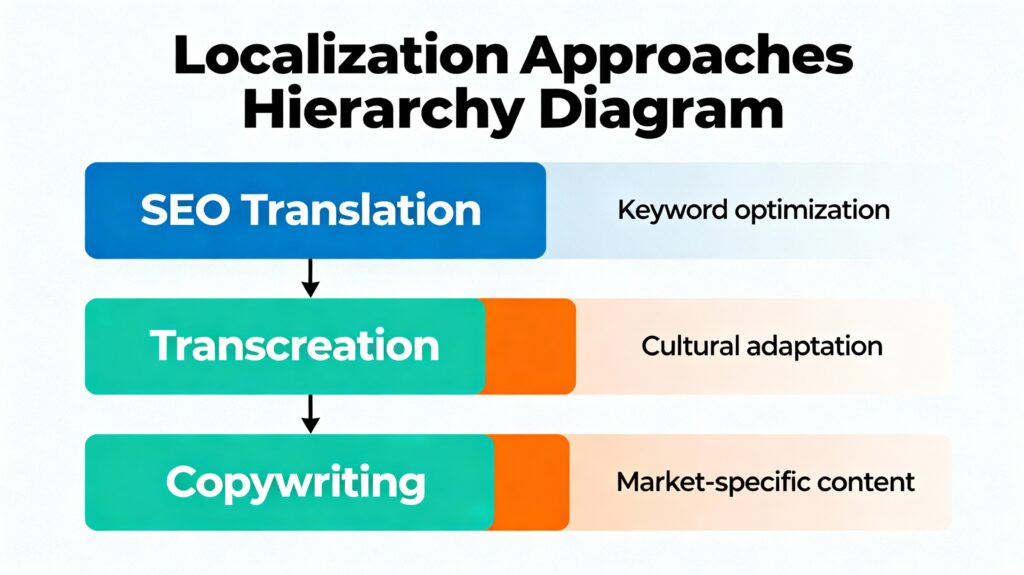
Three professional approaches to content localization for global markets
SEO-Focused Translation
Your marketing copy gets translated by professionals who understand both language and search optimization. The translator receives your keyword research, understands your SEO objectives, and ensures that every localized page ranks for the right terms while reading naturally.
This is professional translation services at its finest—combining linguistic precision with strategic SEO intent.
Transcreation (Creative Localization)
Some content can’t simply be translated; it must be recreated for the target culture. An international fashion brand emphasizes winter apparel in Norway but summer collections in Spain. The messaging, examples, and even product focus shift.
Transcreation means a skilled linguist rewrites entire sections, adapts tone, inserts local examples, and preserves brand voice while making content feel native to the target market.
New Local Copywriting
Customer needs genuinely differ by country. German software customers prioritize data protection differently than American customers. A SaaS platform’s German website should emphasize compliance and security features prominently, while the U.S. site might focus on speed and integration.
This requires more than translation—it requires market-specific content strategy and copywriting.
The Critical AI Warning
Yes, AI translation tools are tempting. They’re fast and cheap. They’re also increasingly problematic.
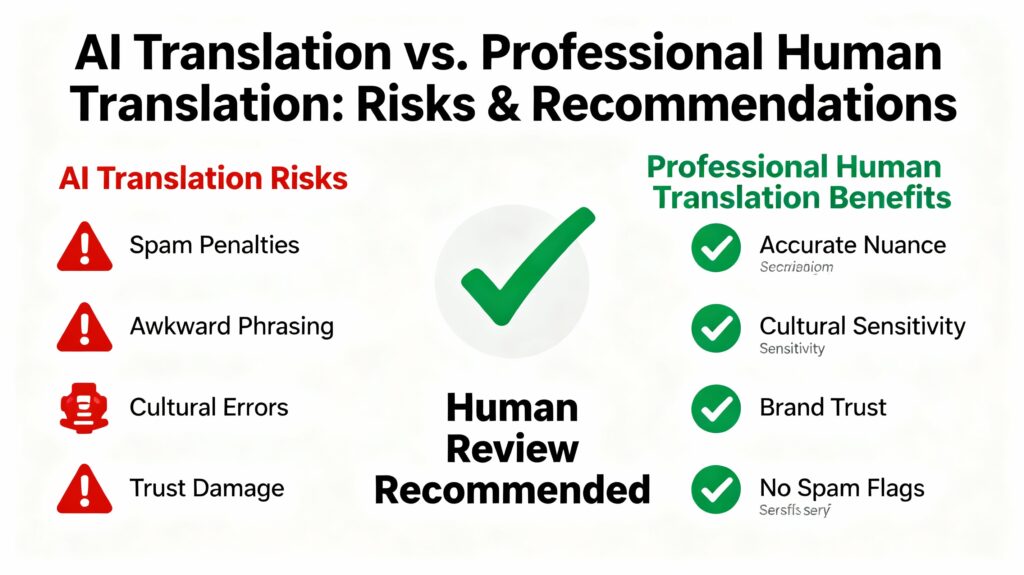
AI-only translation risks spam penalties and damages user trust
Google’s 2024-2025 spam policies explicitly state that AI-generated content without human editorial review may be classified as spam. Beyond the ranking penalty, machine-translated content typically suffers from awkward phrasing, cultural misalignments, and errors that damage user trust.
AI translation is valuable for internal documentation, product support materials, and non-customer-facing content—especially when paired with human post-editing. But for customer-facing marketing, landing pages, and SEO-critical content? Professional human translation is mandatory.
Applied Lingo combines AI efficiency with human expertise through ISO-certified review processes, ensuring quality consistency without the spam risk.
Step 9: Maintain and Expand International Content Continuously
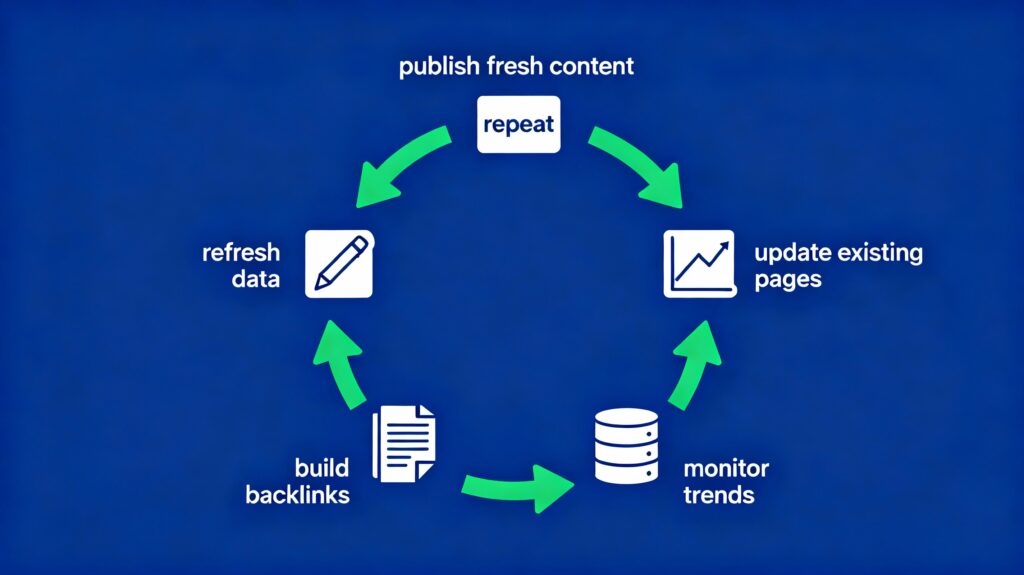
International SEO requires continuous content investment and optimization
SEO success requires treating localized websites as living entities, not static assets.
Ongoing optimization includes:
Publishing fresh, locally relevant content monthly
Updating existing pages to reflect market changes and emerging keywords
Monitoring local search trends and competitor moves
Building additional local backlinks as your authority grows
Refreshing outdated case studies, statistics, and examples
Many companies localize a website, declare victory, and then neglect it for months. That’s a missed opportunity. Consistent content investment compounds—each new article, each updated page, each earned backlink strengthens your domain authority in that market.
Workflow recommendation:
Pair your CMS (WordPress, Webflow, etc.) with a translation management system. Therefore, this allows your content team to publish once in your primary market, then trigger translations, localization reviews, and publication across all target markets through an integrated workflow.
An approach like this scales localization without chaos—essential when managing 5, 10, or 50 language variants simultaneously.
The Applied Lingo Approach to Global SEO Success
Building an international SEO strategy isn’t just about technical setup—it’s about creating genuinely local experiences that earn trust, drive engagement, and convert across cultures.
At Applied Lingo, we’ve spent years perfecting this balance. We combine:
Strategic keyword research tailored to each market’s actual search behavior
Professional translation services that prioritize SEO alongside linguistic accuracy
Native cultural expertise ensuring your brand voice resonates in every market
Ongoing optimization that treats localized content as a continuous investment
Whether you’re launching your first international website or scaling across 20 markets, Applied Lingo specializes in making global expansion profitable and sustainable.
Key Takeaways: Your Path Forward
✓ Start with data: Use GA4 and competitive analysis to identify high-potential markets
✓ Choose your structure: Subdirectories offer scalability; ccTLDs maximize local trust
✓ Build solid foundations: Hreflang, CDN, and local backlinks aren’t optional
✓ Research locally: Native speakers, not literal translations, guide keyword strategy
✓ Audit strategically: Repurpose what works; create fresh content for new markets
✓ Localize professionally: Transcreation and SEO translation beat machine automation
✓ Invest continuously: SEO is a marathon—consistent content expansion drives long-term growth
Ready to Scale Globally?
Applied Lingo specializes in helping ambitious brands expand into new markets through strategic SEO and expert localization. Our team combines professional translation services with deep SEO expertise—ensuring your global website ranks, resonates, and converts.
From translation services that prioritize search rankings to professional document translation services that balance cultural nuance with keyword strategy, Applied Lingo is built for international brands serious about sustainable growth.
Let’s discuss your global expansion goals. To start your journey toward meaningful international visibility Request Free Quote or Contact Applied Lingo




